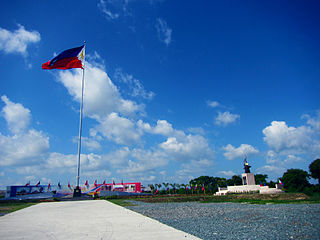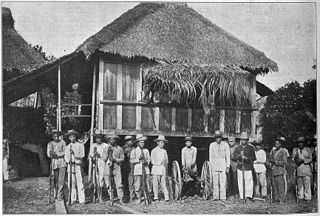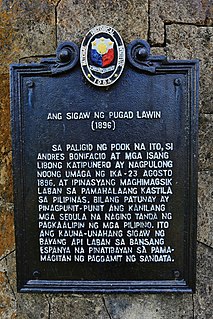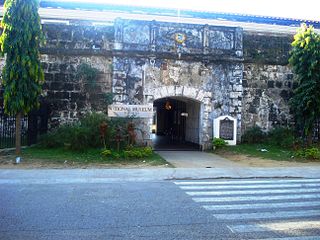 W
WThe Battle of Alapan was fought on May 28, 1898, and was the first military victory of Emilio Aguinaldo after his return to the Philippines from Hong Kong. After the American naval victory in the Battle of Manila Bay, Aguinaldo returned from exile in Hong Kong, reconstituted the Philippine Revolutionary Army, and fought against a small garrison of Spanish troops in Alapan, Imus, Cavite. The battle lasted for five hours, from 10:00 A.M. to 3:00 P.M.
 W
WThe siege of Baler was a battle of the Philippine Revolution. Filipino revolutionaries laid siege to a fortified church manned by Spanish troops in the town of Baler, Aurora, for 337 days, from 1 July 1898 until 2 June 1899.
 W
WThe Battle of Manila, sometimes called the Mock Battle of Manila, was a land engagement which took place in Manila on August 13, 1898, at the end of the Spanish–American War, four months after the decisive victory by Commodore Dewey's Asiatic Squadron at the Battle of Manila Bay. The belligerents were Spanish forces led by Governor-General of the Philippines Fermín Jáudenes, and American forces led by United States Army Major General Wesley Merritt and United States Navy Commodore George Dewey. American forces were supported by units of the Philippine Revolutionary Army, led by Emilio Aguinaldo.
 W
WThe Battle of San Rafael fought between Filipino revolutionaries under the leadership of Anacleto “Matanglawin” Enriquez against the Spanish army headed by Commandant Lopez Arteaga.
 W
WThe Battle of Zapote Bridge was fought on February 17, 1897 as part of the Philippine Revolution. Filipino revolutionary forces led by General Emilio Aguinaldo defeated Spanish forces under the command of Governor-General Camilo de Polavieja. In this battle, General Edilberto Evangelista was killed.
 W
WThe Battle of Binakayan–Dalahican was a simultaneous battle during the Philippine Revolution that was fought on November 9–11, 1896 that led to a decisive Filipino victory. The twin battle took place at the shores of Binakayan, in the town of Cavite Viejo ; Dalahican and Dagatan in Noveleta; and, to minimal extent, in Imus and Bacoor towns in Cavite, Philippines that lasted for two days before the Spanish army retreated demoralized and in disarray. The result of the battle was the first significant Filipino victory in the country's history.
 W
WThe Cry of Pugad Lawin was the beginning of the Philippine Revolution against the Spanish Empire.
 W
WThe Battle of Imus, or the Siege of Imus, was the first major battle of the Philippine revolution against the Spanish colonial government in the province of Cavite. It was fought between September 1–3, 1896 at Imus, Cavite province in the Philippines, right after Bonifacio's ill-fated attack on the gunpowder magazine at the Battle of San Juan del Monte in Manila.
 W
WThe Battle of Kakarong de Sili was fought on January 1, 1897, at Pandi, Bulacan, in the Philippines. The Kakarong Republic, based in the little fort in Pandi, was attacked by a force of Spaniards who massacred the Katipuneros there. At the end of the battle, General Eusebio Roque was captured by the Spaniards. The Kakarong republic was considered the first republic formed in Bulacan and in the Philippines.
 W
WThe Battle of Manila of 1896 occurred in Manila in then Spanish colony of the Philippines during the Philippine Revolution. Katipunan under Andres Bonifacio attempted to take the city but the attempt failed, and Bonifacio retreated to the city's outskirts. The Battle of San Juan del Monte was joined a day later when Bonifacio attempted to capture the San Juan's powder magazine, but this too failed.
 W
WThe Battle of Noveleta was a major battle during the Philippine revolution and was one of the first engagements of the revolution in Cavite. In the latter part of the revolution, Noveleta played a key role for the Magdalo and Magdiwang factions. From its capture by the Magdiwang at the start of the revolution, various battles were fought and won by Filipino rebels in Cavite. Noveleta became the seat of the Magdiwang faction of the Katipunan.
 W
WThe Battle of Pasong Tamo was a series of short skirmishes shortly after the Cry of Balintawak between the remaining Katipuneros in Caloocan and the Guardia Civil.
 W
WThe Raid on Paombong was organized and executed on September 3, 1897, between the Philippine revolutionaries led by Captain Gregorio del Pilar on a blitzkrieg attack on the Spanish church and convent in the municipality of Paombong.
 W
WThe Retreat to Montalban occurred during the Philippine Revolution after the 1897 Battle of Naic southwest of Cavite when Philippine General Emilio Aguinaldo's and his forces retreated to Puray, Montalban on June 14. The Spanish pursued the Katipunero forces retreating towards central Luzon, killing many of the revolutionaries. However, the retreat finally ended when Aguinaldo and the Filipinos won the Battle of Mount Puray, from which he would make his temporary headquarters, relocating it again to Norzagaray and Angat, until finally reaching the caves of Biak-na-Bato on June 24, 1897 and making it the new revolutionary headquarters.
 W
WThe Battle of Sambat was the culminating battle of the first revolts of the Katipunan in Laguna. The battle was the final major action for the Katipunan chapter of "Maluningning" ending in the defeat of the rebels and martial law in Laguna province.
 W
WThe Siege of Fort Pilar was fought between April and May 1899 on then-town of Zamboanga in Mindanao as a part of the Philippine Revolution. One of the only few actions against Spanish colonials forces in Mindanao, the victory brought about by the Zamboangueño Ethnolinguistic Nation, after their capture of Fort Pilar several weeks later, paved way for the foundation of the short-lived Republic of Zamboanga.
 W
WThe Battle of Tres de Abril occurred in 3 April 1898, during the Philippine Revolution. It was fought in the city of Cebu, a month after the Revolt of Cebu began.